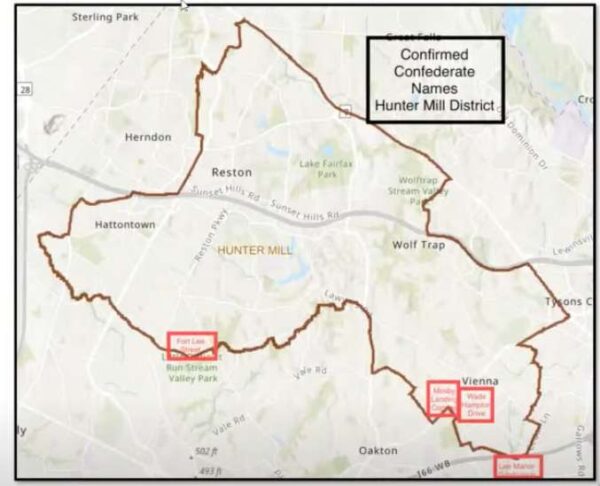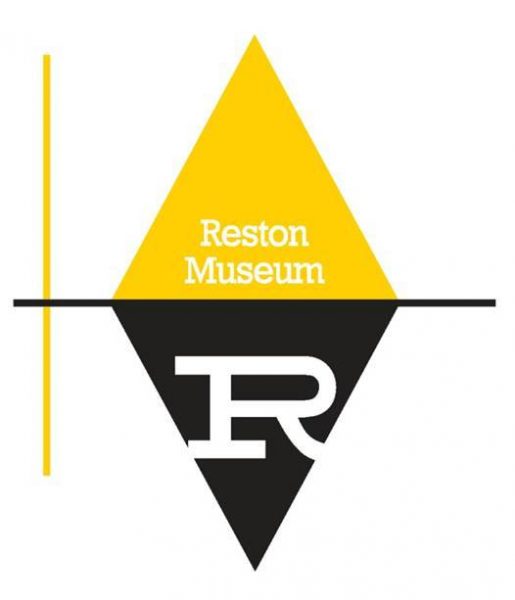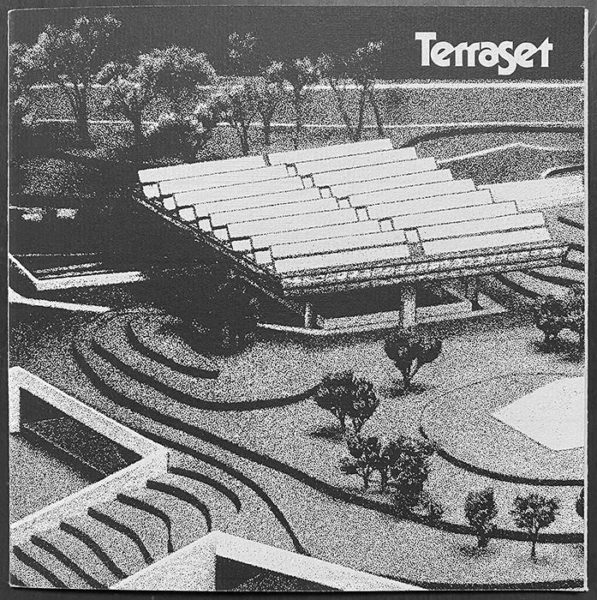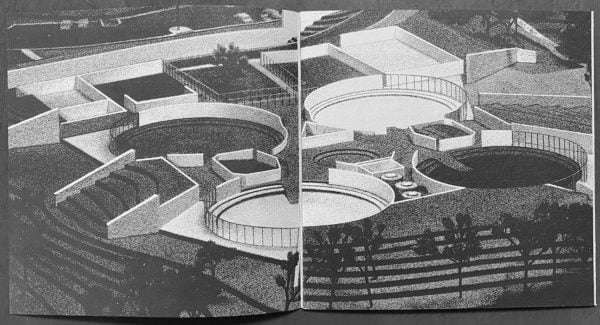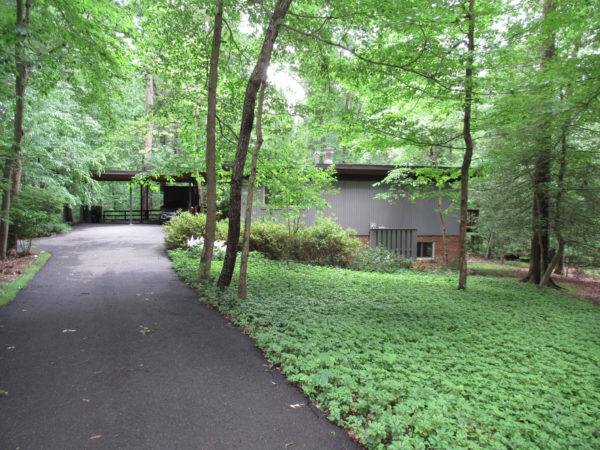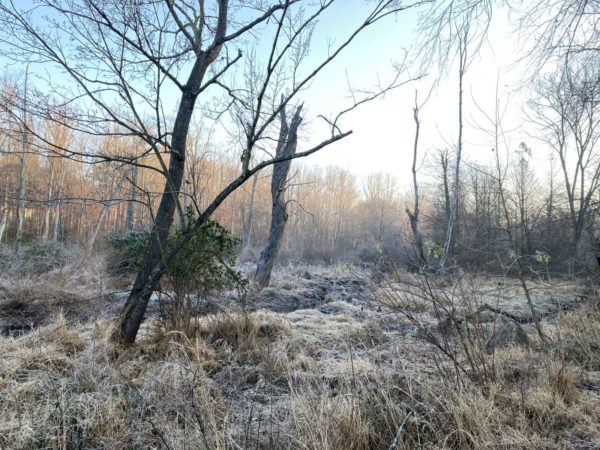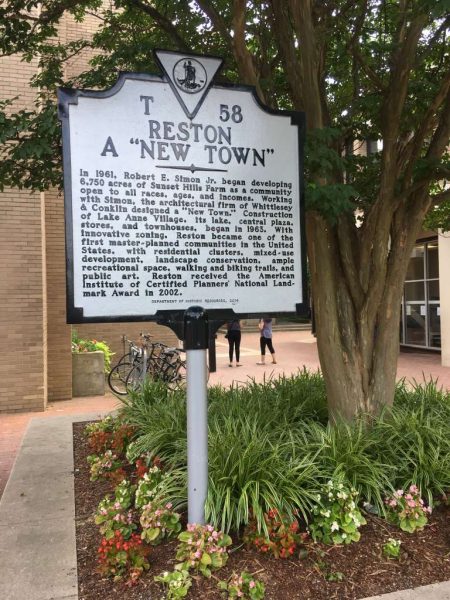A Warning About Building Fires — The Fairfax County Fire and Rescue Department is encouraging residents to take an active role in practicing and promoting safe behavior during Get in STEP, which stands for Safety Takes Every Person, with FCFRD this week. This week’s highlight is heating safety. [FCFRD]
Plastic Bag Tax Goes into Effect Soon — A five-cent tax on disposable plastic bags provided by retailers in grocery stores, convenience stores, and drugstores will go into effect on Jan. 1. The county’s board passed the tax on Sept. 14. [Fairfax County Government]
Deep Dive into Effects of Segregation in Northern Virginia — A new report by the Northern Virginia Health Foundation and the Center on Society and Health at Virginia Commonwealth University offers new insights on the history of exclusion and segregation in Northern Virginia. [Reston Patch]
Photo by Marjorie Copson
Reston history will take center stage at the 19th annual Reston Home Tour on Oct. 16.
This year’s tour will feature five houses, including the first home built on Lake Thoreau (before the lake was even there), a work by Restonian architect Ken Bonner, and the Craftsman-inspired The Kensington Reston that overlooks the 11th fairway of Reston National Golf Course.
The tour is hosted by the Reston Museum and is self-guided. Each ticket includes a guide book with descriptions and a map. A boxed lunch will be available for purchase at The Kensington, a local assisted living community.
Additionally, the museum will be open to the public with its newest exhibit “Early Reston Home Interiors” on display.
Masks are required on the tour, and tickets are available now for $30, though museum members can get tickets at a discounted price. Docents and volunteers are still needed.
Reston Museum Executive Director Alex Campbell says it’s wonderful to have the home tour back after it was canceled last year.
“The Reston Home Tour is an important event as it showcases the creativity and ingenuity that Restonians implement within their home through modern renovations,” she wrote in an email to Reston Now. “…The tour is a reminder that not only did Reston begin as a community that embraced architectural variety and modern design, it is still today a community where Restonians pursue modern and forward-thinking design for their homes.”
It is the Reston Museum’s biggest fundraisier and one of its most popular events, Campbell notes.
The Reston Museum reopened to visitors about a year ago after being closed for a number of months due to the COVID-19 pandemic. The 24-year-old museum has embraced the digital world in order to stay afloat.
Staff have started to do more in-person events recently, including an outdoor “Storytime for Little Historians.”
Campbell says the home tour is an “an important contributor in supporting our mission to preserve and share Reston’s history.”
Previous iterations of the Reston Home Tour have showcased a five-decade-old Dutch Colonial and a 1960s Hickory Cluster townhouse.
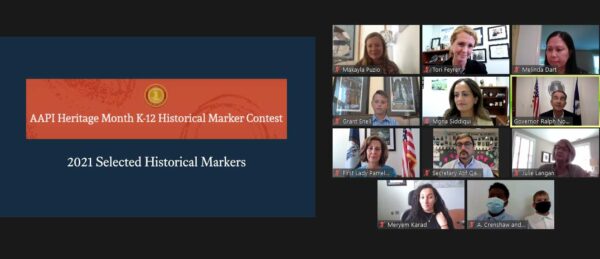
Local students are responsible for two new state historical highway markers that Virginia will install in recognition of Asian American Pacific Islander (AAPI) history.
Earlier this summer, students from across the Commonwealth submitted ideas for new historical markers as part of a contest celebrating AAPI Heritage month. Gov. Ralph Northam announced five winners on Aug. 3, including two that were submitted by students from the Fairfax County area.
Students from Hunters Woods Elementary in Reston nominated W.W. Yen for a marker. He was the first international student to earn a bachelor’s degree at the University of Virginia and went on to become an important leader in Chinese government. The school now has a dorm and scholarship named after him.
Mary Ellen Henderson Middle School students in Falls Church proposed highlighting their city’s Vietnamese immigrant community, which grew after the Fall of Saigon in 1975. During the subsequent surge in immigration to the U.S., many of the people who came to the D.C. area settled in Arlington’s Clarendon neighborhood and, later, Falls Church.
Today, the D.C. area is home to the third-largest Vietnamese community in the country, and the Eden Center is among the largest Vietnamese shopping centers.
The other new historical highway markers highlight Japanese American football player Arthur Azo Matsu, former Korean foreign minister Kim Kyusik, and Filipinos who served in the U.S. Navy.
“Throughout history, Asian American and Pacific Islander communities have made significant contributions to our Commonwealth and our country, but too often their stories remain untold,” Northam wrote in the press release. “As we continue working to tell a more comprehensive and inclusive Virginia story, I am grateful for the efforts of Virginia students and educators in helping elevate the voices of prominent AAPI Virginians with these five new historical markers.”
Now a rising fifth-grader at Hunters Woods Elementary, Benjamin Roxbury was in fourth grade when he and a few other students nominated Yen for the historical marker contest.
He hopes when people read it, they discover that learning is universal.
“Families may come from different parts of the world, but school brings us together,” Benjamin said. “I like that we get to learn from different people.”
Makayla Puzio, who taught him last year, says school officials told her about the contest and she thought it would be a good hands-on, project-based assignment to help students learn about state history and how to conduct research.
Other figures suggested by students in Puzio’s fourth-grade class included local author Helen Wan and peace activist Marii Kyogoku Hasegawa. But the nomination from Benjamin’s group ultimately stood out to the Virginia Department of Historic Resources, which chose the new markers.
“They were really excited,” Puzio said of the students’ reaction to their selection. “It makes them feel proud of the work that they did. I don’t know if they really thought that was going to happen.”
For Griffin and Oliver Hardi, the Henderson Middle School students behind the Eden Center marker, the opportunity to honor the local Vietnamese community and tell their stories resonated on a personal level.
“Our mom is an immigrant too, so it’s great to see Asian-American history recognized,” Griffin said by email. “And the food at the Eden Center is great!”
Puzio says this experience could become a point of pride for these students for the rest of their lives.
“One of these students could be touring UVA and remember this person and historical marker,” said Puzio. “And be like ‘hey, in fourth grade, I did this. I’m the reason that this marker is here!”
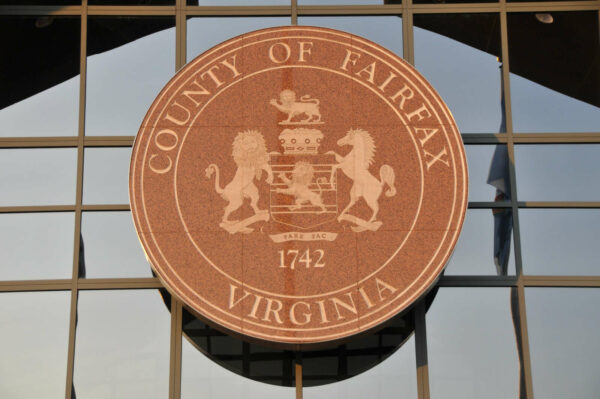
(Updated, 12:20 p.m.) The Fairfax County Government Center, where county policy is created and official functions take place, is an imposing, modern-looking building. Above the main doors is the county seal: a royal-looking crest with lions, a horse, and the date “1742.”
Unlike the building, the seal is of a different time. Adopted seven decades ago, it bears a version of the coat of arms belonging to Thomas Fairfax, the sixth Lord Fairfax and a slaveholding British loyalist who once owned much of the land that makes up Fairfax County today.
As neighboring counties and cities reexamine their logos and symbols, it seems like only a matter of time before Fairfax County faces its own questions.
When asked if there’s been discussion about further research into the county logo, representatives of the Fairfax County History Commission said it’s not on the agenda or a priority right now.
The commission is currently undertaking an inventory of local African American history after completing one about Confederate names on public places.
Fairfax County Board of Supervisors Chairman Jeff McKay wrote in a statement to Reston Now that officials are listening to the community but have yet to hear about any issues with the county seal.
America was unfortunately built in part through the oppression of people of color. We cannot separate this history from Fairfax County, but we can listen to the community on what symbols are continuing to create divisiveness and inequity. Symbols of the Confederacy, for example, do not speak to the County’s values today, so we are working to remove these through the proper processes. Currently, there are ongoing efforts to change road names as well as other Confederate symbols and the Board previously took action to remove the monument of John Quincy Marr from the courthouse. We have not heard from our community members that these same messages are felt from the County seal. We continue to invest significant resources into our historically underserved communities to ensure that everyone has the opportunity to thrive in Fairfax County.
The county selected the seal as its logo in 1949 ahead of an impending visit from the then-Lord Fairfax. It won over a dozen other seals belonging to the Fairfax family due to “its clarity when reproduced,” according to historical documents from Fairfax County Public Library’s Virginia Room.
A county flag with the seal was unveiled on June 13, 1968, the day before Flag Day, in response to repeated requests for a flag from county schools.
“We probably ought to have a Betsy Ross here to get the flag ready for Flag Day,” said Gil Shaw, the flag’s creator and the county’s director of information services at the time. “But the coat of arms of Thomas Lord Fairfax will soon fly over the lands he once owned and which became Fairfax County in 1742.”
Early colonial Virginia land history is admittingly a bit confusing due to the limited availability of written records and a lack of variety in names.
“The famous one, for our purposes, was the sixth Lord Fairfax,” explains Steve Harris-Scott, an assistant professor in George Mason University’s history department and an expert on colonial Virginia history.
“The nobles generally passed on their names to their first-born son, so when they took over the title, they were all the same names,” he said. “There was a Thomas Fairfax, first Lord Fairfax, then there was Thomas Fairfax, the second Lord Fairfax, etcetera.”
The sixth Lord Fairfax was born in England in 1693 to the fifth Lord Fairfax and Catherine Culpepper.
Through his mother’s side, he inherited about 5 million acres of land in 1710 known as the “Northern Neck,” which encompassed today’s Fairfax County. Taken from the indigenous people who had lived there for centuries, the land was a gift to Catherine’s father, Thomas Culpepper, from the restored King Charles II for his support during the English Civil War.
“[This land] is essentially bordered by the Rappahannock [River] on the south and the Potomac on the north,” Harris-Scott said.
However, Fairfax spent most of his life in England and didn’t move to Virginia until 1742, the date on the county’s logo. He also may never have resided in what is now Fairfax County, according to Harris-Scott. Read More
Prosecutor Calls for State Investigation of Traffic Stop — Commonwealth’s Attorney Steve Descano has called on Virginia State Police to conduct an internal investigation of a potential violation of the state’s new ban on pulling people over for dark taillights. The county has dropped all charges against a Black woman who was pulled over on the Capital Beltway by a state trooper. [Associated Press/WTOP]
Metro Behind on Safety and Training Protocols — A Washington Metrorail Safety Commission audit of Metro’s signal and automatic train control system found that the transit system has failed to keep up “with preventive maintenance, lacks needed safety certifications and is not training employees on how to maintain the system’s complex equipment and machinery.” [The Washington Post]
Association Drive Among Endangered Historic Places — Preservation Virginia included Reston’s Association Drive Historic District among Virginia’s Most Endangered Historic Places, a list released each May to mark National Historic Preservation Month. The business park is considered threatened because of the Soapstone Connector project. [Independent-Messenger]
Reston Business Owner Featured on Today Show — Reston resident Radhika Murari appeared on The Today Show yesterday for an Asian American and Pacific Islander Heritage Month segment that highlighted her work as the founder of OmMade Peanut Butter. [Supervisor Walter Alcorn/Twitter]
Photo by Fred Dews/Twitter
Hunter Mill District Supervisor Walter Alcorn hosted a town hall on Tuesday (April 20) to talk about public places in Fairfax County named after Confederates.
The discussion was based on the Fairfax County History Commission’s 539-page inventory, which was first released in December and details the history and context of each place named after a prominent Confederate figure.
The project traces its roots to last summer, when the Fairfax County Board of Supervisors directed the commission to study the legal and financial implications of possible name changes throughout the county.
The commission determined that, out of about 26,500 total named places in the county, approximately 157 streets, parks, monuments, subdivisions, and public places in Fairfax County bear names with ties to the Confederacy.
“This research confirmed…that Fairfax County was a crossroads of war,” Fairfax County History Commissioner Barbara Naef said. “Combatants of both Union and Confederates flourished, camped, marched, clashed, and suffered both victory and defeat here.”
In addition to cataloging sites, the report provides appropriate context, history, and narrative for possible name change discussions, including a dive into “Lost Cause” ideology, its pervasiveness in Fairfax County, and how it influenced the naming of places.
The Lost Cause ideology encompasses myths used to rationalize Confederacy sympathy, mainly that the Civil War was not fought over slavery, the pre-war Southern way of life is to be celebrated, and that prominent figures like Confederate Gen. Robert E. Lee didn’t believe in slavery.
“There was an urging by some to exclude it from the report altogether or soften its tone,” Naef said. “These reactions prove the point. The perspective of the Lost Cause has been embraced by generations.”
In its report, the History Commission recommended making the inventory available to the public via the Fairfax County Public Library, which is currently the case, and using the report as a guide for “a robust public process for considering future actions.”
The Hunter Mill District town hall is one of the first steps in that process, members of the commission at the meeting noted.
Within the Hunter Mill District, there are believed to be four places named after Confederates: Fort Lee Street, Lee Manor, the Mosby’s Landing condominium complex, and Wade Hampton Drive.
Fort Lee Street in Herndon and Lee Manor along Lee Highway near Vienna both derive their names from Robert E. Lee.
Fort Lee Street was named in the mid-1970s when Fox Mill Inc. developed the Folkstone subdivision, while Lee Manor is directly tied to Lee Highway, which is in the process of being renamed.
The Virginia General Assembly passed a bill in February, allowing Arlington to rename their portion of Lee Highway.
Mosby’s Landing in Vienna takes its name from John Mosby, a Confederate commander who was also known as the “Gray Ghost.” The condo complex was built on the site where legend says that Mosby and his horse hid out from Union soldiers.
Vienna’s Wade Hampton Drive is named after a Confederate lieutenant general who reportedly led a unit of 600 men and horses down the road in 1865. After the war, Hampton criticized Reconstruction and worked to suppress the vote among South Carolina’s Black population when he became governor of the state.
According to the history commission, the Town of Vienna named the street after Hampton in recognition of the Civil War’s 100th anniversary. The town is currently in the process of having the road’s name changed.
“The town has appointed an ad hoc group to look at this street name and consider alternatives,” Fairfax County History Commissioner Anne Stuntz said.
While the Commission’s charge was to examine places named after Confederates, several residents suggested that places named after individuals involved in the “Mass Resistance” movement opposing school integration should also be re-examined.
Examples include former Fairfax County Public Schools Superintendent W.T. Woodson, who opposed desegregation and still has a high school bearing his name, though schools were overall not included in the history commission’s inventory.
Commenters also mentioned Carter Glass, a state senator who developed laws intended to prevent Black people from voting, including Virginia’s poll tax.
For years, the library at Lake Anne Plaza in Reston was named after Glass. Today, that building is now the Reston Museum.
Photo via Fairfax County/YouTube
The Reston Historic Trust & Museum is seeking feedback from the community as it plans for the future.
The nonprofit organization has launched an online survey for people who are familiar with the museum for feedback on programs and exhibits, what Reston history topics are of interest and what the preferable format is to learn about Reston history.
The survey is comprised of 21 questions and is available to be filled out until March 17. A 10% discount on shop items is being offered to those who fill out the survey and provide their email.
The museum is open Monday through Friday, 11 a.m. to 4 p.m. as volunteers are available. It is also free of charge.
The organization conducts educational and public programming, exhibitions and public events. It also offers a number of online resources including a digital history map of Reston, a brief history of the town and kids activities.
Monday, Feb. 8
- Have a Heart (10 a.m. to 3 p.m.) – Give a heart to all of your Valentine’s. Using wet felt techniques (and no needles) create and decorate a heart as you see fit. Hosted at Sully Historic Site, the program is 30 minutes and can accommodate up to four people within the same family.
Tuesday, Feb. 9
- Indian Desserts, No-Bake (2:00 p.m.) – Join for a virtual demonstration on how to make popular easy, no-bake Indian desserts. Hosted by the Kings Park Regional Library in Burke, the event is designed for adults and teens.
Wednesday, Feb. 10
- Before 1964: The History of Reston’s Predecessors (7:00 p.m. to 8:30 p.m.) – Travel back in time to learn about Reston before there was a Reston. Join the Reston Historic Trust & Museum to discover the origins of names like Baron Cameron, Wiehle, and Bowman.
Thursday, Feb. 11
- Crash Test Dummies (4:30 p.m. to 5:30 p.m.) – Get a behind-the-scenes virtual tour of the non-profit Insurance Institute for Highway Safety‘s Vehicle Research Center. Crash test engineer Becky Mueller is the guide, explaining the importance of the institute, introducing crash test dummies, and running a real crash test.
Friday, Feb. 12
- Date Lab Comes To Life (5:00 p.m. to 6:00 p.m.) – The popular Washington Post Magazine Date Lab column is coming to virtual life. Presented with the Smithsonian American Art Museum, Date Lab writers and editors are discussing what it’s like to date during the pandemic. Plus, there’s a Q & A with a successfully matched Date Lab pair.
Saturday, Feb. 13
- Afternoon with Culinary Historian Michael W. Twitty (3:00 p.m.) – Hear from famed author and historian Michael Twitty, who’s most known for tracing his culinary ancestry from Africa to America. The talk takes place at the Reston Community Center, but with very limited seating available and masks required.
- Starting with Seeds (10:30 a.m. to 12 p.m.) – Learn to grow your garden from seeds by heading out to Alexandra’s Green Spring Gardens. Staff member Susan Eggert will walk attendees through potting mixes, containers, seed treatments, lighting, fertilization, watering, sources, and timing. At the end, all will get a few seeds to take home and try themselves. Limited tickets available and masks required.
Sunday, Feb. 14
- Galentine’s Day Cycling (10:30 a.m.) – New Trail Cycling and Fitness Studio is hosting a fitness class and “virtual shop party” with local, women-owned businesses to celebrate Galentine’s Day (a holiday celebrating female friendships created by the show Parks & Recreation). 100% of ticket sales goes to Shelter House, a local non-profit dedicated to helping victims of domestic abuse.
Photo via kaboompics/Pixabay
Going to school at Terraset Elementary in the late 1970s was sort of like being in the movie Star Wars.
A steel latticework topped with 13,000 square feet of solar panels covered the main courtyard of the school, at times creating eerie-looking shadows.
Spiraling concrete staircases looked out of this world.
The building itself was built into a side of a hill with the roof covered with a five foot layer of dirt, giving an appearance of being remains of a lost civilization.
“My memories of the architecture was that it was very futuristic,” says Kristina Alcorn, who attended the sixth grade at Terrset in 1979. “This wasn’t very long after Star Wars had come out… so, I’m sure some of our games running around the playground involved Princess Leia.”
Terraset Elementary School at 11411 Ridge Heights Road was completed in 1977 with the intention of thematically matching Reston’s ahead-of-its-time aesthetic.
“In a lot of ways, Terraset fits in with Reston as a whole,” says Alex Campbell, executive director of the Reston Museum. “Taking a chance, trying something new, thinking ahead.”
Terraset was specifically designed with the 1970s energy crisis in mind. It was one of the first solar energy powered schools in the country. The school was also built into the hill in hopes that the dirt covering would provide natural insulation and cut fuel costs.
The name “Terraset” actually means “set in Earth.”
Then, there was the large array of solar panels, which were paid for by a Saudi Arabian prince.
When the school got turned down for a grant by the US government, Fairfax County school system turned to Prince Fahd of Saudi Arabia. The prince provided a $650,000 grant to the school for the school’s solar and heating system.
Fahd would later become King and, in 1985, President Ronald Reagan toasted him at a state dinner for providing financial help to the Reston elementary school.
At the school’s dedication ceremony in May 1977, Fahd was joined by another Saudi prince, Prince Saud al-Faisal, in taking a tour of the school. It was acknowledged that it was odd that a prince from an oil-rich country would so publicly support an American solar-powered project.
“Why . . . would any Saudi do anything that could conceivably compete with oil?,” Saud said at the dedication, according to the Washington Post. “We are very much aware of the finite nature of many natural resources. Even though we continue to find additional oil deposits in our country, we know that there is an eventual limit to what we can produce. One of the sources of energy that we expect to utilize as our oil production declines, is solar energy.”
But the design had major flaws.
Most notably, the solar panels were constructed with Saudi Arabia’s climate in mind, which is far different from Reston’s climate.
“[The solar panels] didn’t deal very well with the change in seasons,” says Campbell. The panels kept having leaks and cracks.
Then, there were the icicles.
“There were these huge icicles that would form on them in the winter,” says Alcorn, who is also on the Reston Historic Trust and Museum’s Board of Directors. “You’d be waiting for your bus down below, watching these huge icicles, and wondering if they were going to hit you or the bus.”
In 1986, less than a decade after being completed and with maintenance becoming unmanageable, the solar panels were turned off. In 1991, the panels were taken down.
It wasn’t a complete disaster, however. The school ended up using about a quarter less energy than other comparable Fairfax County schools during the nine years the solar panels were in operation.
Today, Terraset Elementary remains the educational home to about 600 students.
While there are no longer solar panels (which makes it currently ineligible for the National Register of Historic Places), the school still very much remains buried under dirt.
While best-laid plans rarely work out, Terraset proves that it’s at least worth trying.
“It was an example of that spirit of ingenuity and hope for the future to solve problems,” says Alcorn. “And not be afraid of sometimes failing.”
Photos courtesy of Terraset Elementary
A new Reston Historic Resources Survey names ten area locations as “potentially eligible” for the National Register of Historic Places.
They include the Ring Road subdivision in North Reston, two area golf courses (Reston National and Hidden Creek), a number of 1960s-and-1970s-era housing clusters, and the Ken Bonner-designed residence on Stirrup Road.
The survey’s goal was to determine significant historic districts and buildings that were constructed during Reston’s prime development years – between 1961 and 1978. It was commissioned by the Virginia Department of Historic Resources and conducted by Mary Hanbury of Hanbury Preservation Consulting, a historic preservation consulting firm out of Raleigh, North Carolina.
The survey covered all of Reston, except for the land within Lake Anne Historic District. This district is already on the National Register of Historic Places.
In a community meeting held last night (Jan 5), Hanbury explained that the survey and field work reconnessicance first began in December 2019. It took the better part of a year to conduct. She reviewed eight potential historic districts and 51 individual properties in Reston.
The survey consisted of photos, locational mapping, creating or finding site plans, and a brief written history of the location.
From this, she determined that ten locations were “potentially eligible” for inclusion on the National Register of Historic Places.
“Potentially eligible” refers to the places that meet the requirements for eligibility for inclusion – meaning they are at least fifty years old (unless in exceptional circumstances), looks much like it did in the past, and has significant historical or architectural value.
However, it’s not up to Hanbury if it will be included on the National Register.
“I can not say that something is eligible for the National Register. That is something that the state department of historic resources also the national park service determines,” Hanbury explains. “But part of this as a professional is to say ‘this is something that I think is potentially eligible.’ Technically, I’m not in power to say that it is [eligible].”
The ten locations are:
- The Hickory Cluster, a modernist group of densely-grouped townhouses designed by Charles Goodman who was hired by Robert Simon.
- Waterview Cluster, one of the earliest subdivisions constructed as part of Simon’s plan for Reston. It was designed by Chloethiel Woodard Smith, who owned at one point the largest architecture firm run by a woman in the U.S.
- Coleson Cluster, built in 1966 and also designed by Smith. The cluster is designed to be walkable and oriented towards public spaces, as opposed to private courtyards.
- Mediterranean Villa Cluster, a rare example of residences designed by Robert W. Davis. He was much more known for hospitals and office buildings.
- Golf Course Island Cluster, designed by Louis Sauer who worked and studied with famed architect Louis Kahn and notable urban planner Edmund Bacon (who happens to be Kevin Bacon’s father).
- Ring Road subdivision, a mix of architecture and building styles focused on a single-family aesthetic that became popular throughout the area in the 1960s and 1970s.
- Wainwright Cluster, a grouping of dense townhouses oriented towards a common space acted as a model for Reston’s master plan.
- Hidden Creek Golf Course and Reston National Golf Course, both designed by a golf-loving engineer Ed Ault. He became a prolific golf course architect who built over 200 golf courses across the east coast over his career.
- 12146 Stirrup Road, designed by Ken Bonner and thought to be the first single-family residence built in Reston.
The survey also namechecks several locations that could be eligible once they hit the fifty year benchmark. They include the Atrium condominiums on Roger Bacon Drive, Sheraton Reston Hotel, and the Fairway Cluster. They all will hit their fiftieth birthday over the next few years.
Additionally, there are few places that the study determined merited “further study” ( including Lake Anne Gulf gas station, Fairway Apartments, and Cameron Crescent Apartments) as well as those that are “likely not eligible” due to significant changes that rendered them too different from when they were initially constructed.
Hanbury cautions that the National Register has very particular rules and regulations and is only one measure of historic importance.
“It is one that is commonly used and a good frame of reference,” said Hanbury. “But they are places that aren’t eligible… that are important and can be locally designated.”
After the presentation, a few members of the community spoke mostly commenting on other historical locations in Reston.
One community member asked why a number of golf courses were included considering that, in his understanding, are “environmental deserts” and were mostly used by “super affluent, white people.”
This comment received several retorts, notably that the golf courses were used by Reston’s diverse population and that local wildlife thrived there.
“The reason the falcons over at Reston Town Center have a place to hunt and eat is because of the open fairways that the Reston golf courses offer them,” said a citizen.
The survey will be used to determine what properties have historical value and should be nominated for historical designation.
It could also inform any future changes to Reston’s comprehensive plan, noted Fairfax County Board Supervisor Walter Alcorn of the Hunter Mill District.
“The report includes recommendations for future documentation and preservation efforts,” wrote Blake McDonald of Virginia’s Department of Historic Resources in an email to Reston Now. “[The department] hopes that Fairfax County will pursue some of these recommendations and we look forward to partnering with them on those efforts.
The public can continue to comment on the survey through January 10.
Photo courtesy of Virginia Department of Historic Resources
Session on Reston Association Election Set for This Week — Reston Association’s elections committee will hold an election information session on Thursday, Jan. 7 at 7 p.m. The session will take place will Zoom. [RA]
Reston Company Taps New Vice Presidents — Reston-based federal contractor Amyx Inc. announced last week it has hired Christopher Ziniti as vice president of defense and promoted Roman Dzialo to vice president of strategic programs. [Virginia Business]
Community Meeting on Reston Historic Resources Survey — ‘A draft of an Historic Resources Survey of Reston has been completed and is available for community review and input. Hunter Mill District Supervisor Walter Alcorn is hosting a virtual community meeting Jan. 5, 2021 at 7 p.m. to provide residents with the opportunity to ask questions and provide comments on the draft survey, following a presentation by the consultant hired by the Virginia Department of Historic Resources.‘ [Fairfax County Government]
Photo by Marjorie Copson
For Reston to move forward, it first has to look back.
Fairfax County recently published a draft of a Historic Resources Survey of Reston for the community to review.
The study is a step toward documenting the historic value of sites in the area for architectural or historic significance. It does not predetermine the future use of any of properties. The survey can be used to identify sites that, if significant, can be nominated to Fairfax County’s Inventory of Historic Sites, the Virginia Landmarks Register or the National Register of Historic Places (NRHP).
Hunter Mills District Supervisor Walter Alcorn is hosting a virtual community meeting on Jan. 5 at 7 p.m. for residents to ask questions and discuss the draft. Questions and discussion will follow a presentation by a consultant hired by the Virginia Department of Historic Resources.
State-hired firm Hanbury Preservation Consulting conducted the survey after Fairfax County was chosen to participate in Virginia’s Survey and Planning Cost Share Program in 2019.
The project provides data on “several residential clusters, a subdivision, two golf courses, two churches, two schools, and a handful of commercial buildings” to be reviewed before consideration for future National Register nomination.
The survey includes a look at 51 individual properties and eight potential historic districts that were built between 1961 and 1978. The eight districts include:
- Hickory Cluster townhouses
- Waterview Cluster townhouses
- Coleson Cluster townhouses
- Mediterranean Villa Cluster townhouses
- Fairway Apartments
- Golf Course Island townhouses
- Ring Road subdivision single-family dwellings
- Cameron Crescent apartments
The eight districts were surveyed to identify boundaries, research historical significance, provide a preliminary count of properties in each district and record each district’s physical characteristics.
The draft shows recommendations for nine resources or sites to be “potentially eligible” for NRHP eligibility. The draft also includes three resources with an “undecided” designation that require further study. It also recommends that any property listed as “potentially eligible or meriting further study should undergo intensive survey in the event of planned demolition or modifications.”
It also includes other recommendations for providing greater reconnaissance-level documentation of buildings that are scheduled for demolition. It also offers recommendations for the county to pursue guidance for the preservation of sites that utilize modern materials such as concrete.
“The Reston community is very proud of our history and our landmarks and we appreciate this opportunity to document our historic resources within an established standard,” Alcorn said in a press release.
“This inventory is an important step toward identifying buildings and places in Reston that should be noted in the Fairfax County comprehensive plan as worthy for their historic value.”
To participate in the Jan. 5 virtual meeting, you can sign in from the county’s website or listen in on the phone by calling 1-844-621-3956 and using the access code: 179 469 1739. The meeting will also be livestreamed on Alcorn’s YouTube channel.
Photo courtesy Reston Historic Trust and Museum

Reston Association Courts Close for the Season — The clay tennis courts at Glade have closed for the season and will reopen in early April. The clay courts at North Hills will close next Monday and will also reopen in early April. [RA]
County Now Offers Contact Tracing Data — The county’s COVID-19 dashboard now includes data on contact tracing. Data show that the county has been able to reach roughly 82 percent of confirmed cases. [Fairfax County Government]
The Early Days of Reston — “At one time, Reston was just a short five to six-minute train ride away from Herndon on the Washington and Old Dominion Railroad,” writes Barbara Glakas. [Reston Patch]
Photo by Marjorie Copson
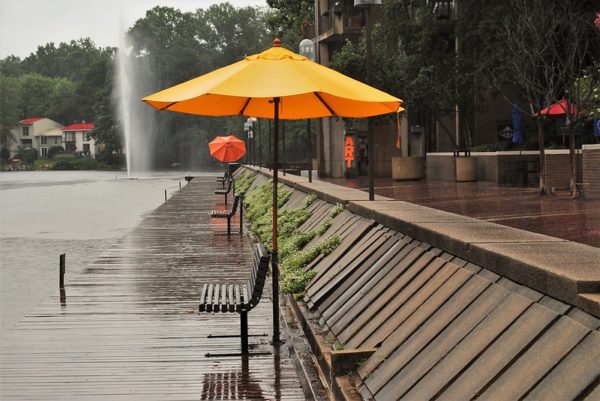
Former Land Planner in Reston Dies — John Veatch worked in Reston’s. Land planning office in the 1960s and helped execute Bob Simon’s vision for Reston. He passed at the age of 80 in Ashburn. [Reston Patch]
Fairfax County Historic Sites Resume Programming — “The Fairfax County Park Authority’s historic sites will begin programming once again, bringing the magic of local history outside, inside and virtually with a focus on family tours, safety and limited indoor access.” [Fairfax County Government]
Community Assessment on Substance Abuse Underway — The Fairfax Prevention Coalition is conducting a community assessment on substance abuse and hosting a series of virtual community focus groups to seek input. [Fairfax County Government]
Photo via vantagehill/Flickr
 This is an opinion column by Del. Ken Plum (D), who represents Reston in Virginia’s House of Delegates. It does not reflect the opinion of Reston Now.
This is an opinion column by Del. Ken Plum (D), who represents Reston in Virginia’s House of Delegates. It does not reflect the opinion of Reston Now.
Virginia and the southern states of the Confederacy lost the Civil War with the surrender of Robert E. Lee to Ulysses S. Grant at Appomattox Court House, Virginia, on April 9, 1865, but for more than another hundred and fifty years it appeared that the South may have won the peace. There was the Emancipation Proclamation, three amendments to the Constitution, and a period of Reconstruction to guarantee the new social order without slavery, but Southerners who favored the old order found ways around the new laws to perpetuate a society of racial segregation and inequalities. Jim Crow laws replaced slave codes, oppressive laws limited the freedoms of Blacks, unequal schools limited their opportunities, and various voting limitations kept Blacks from registering and voting. There were thousands of lynchings to remind Blacks of their status in society and a Lost Cause movement that erected thousands of monuments in celebration of the old order of white supremacy.
After World War II, historian C. Vann Woodward wrote that America went through a Second Reconstruction as Blacks started to win significant victories against racist policies and laws with the various civil rights laws that passed including the Voting Rights Act of 1965 and Supreme Court decisions like Brown v. Board of Education ending school desegregation. Even those advances were short-lived and limited; the Voting Rights Act was repealed, and inequities suffered by Blacks in educational programs and employment persisted. The mistreatment of Blacks by policing authorities became more tolerable than society could stand.
A series of events over many years culminating with a police officer murdering George Floyd from his knee on Floyd’s neck signified that, like the original Reconstruction, the Second Reconstruction left many inequalities and much work to be done. The Black Lives Matter message seems finally to have been heard and finally for many understood. There is no postponing change.
Much of what has been happening to date in what Rev. William Barber II has termed a Third Reconstruction has been symbolic but important. No longer do visitors to the original House of Delegates chamber in the Capitol in Richmond have to walk around a bigger-than-life and impossible-to-miss statue of Robert E. Lee. While his statue on Monument Avenue remains at present, it too will be taken down as soon as the court case about it is resolved. Throughout Virginia and the South more statues have been removed along with other symbols of the old South. Even the state of Mississippi gave up the Confederate flag as part of its flag.
More meaningful changes are coming. As a member of the House Public Safety Committee I am pleased with the public testimony we received last week. Other hearings are scheduled for this week and next to determine the changes we need to make in our policing policies and criminal justice system to remove the racial biases. We will enact important changes at a special legislative session in August. We have had two chances at getting reconstruction right for all our citizens; we must commit ourselves to making this third effort a charm!
File photo




